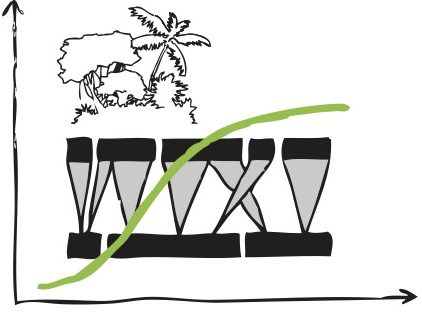

Within the context of REASSEMBLY, I study dung beetle trophic network reassembly across a forest recovery gradient in the Ecuadorian Chocó. Dung beetles are good predictors of habitat quality. First, because they are sensitive to environmental changes brought about by deforestation and because they depend upon medium- to large-bodied mammals for sustenance. This means they are indicators of both environmental changes caused by habitat conversion and hunting pressures. The dung beetles within our sites in Ecuador have responded strongly to changes in habitat.
Of the many themes I address in my research into dung beetle trophic networks, I find two of my methodologies most exciting. First, I use dung beetle gut content DNA to create dung beetle-mammal dung networks. This method allows us to overcome some of the logistical issues around procuring enough different types of mammal dung for large-scale experiments of dung beetle-mammal dung networks. The second is modular insect camera traps, which allow for more detailed studies of dung removal and secondary seed dispersal by dung beetles. The cameras themselves are highly customizable, which allows them to be optimized for the research question and study organism. They are also easier to repair with more affordable parts than traditional camera traps.
In addition to the work in SP6 with dung beetles I have also assisted CM (the central module) as needed. This has largely involved assisting in the infrastructure for the larger project, and collection of baseline data. Some of those contributions include, suggesting sample sites (plots), assisting in the marking of plots, then vegetation removal with the PREX team, and last year assisted in the coordination of the field work for CM while between project coordinators, among others. This was a valuable experience that really helped me to understand the project as a whole.


Video of some of the dung beetles from Canandé and Tesoro Escondido
Before REASSEMBLY
I have taken a non-traditional path to a doctoral program. While I think I always knew I would get my doctorate, I pursued other opportunities first. After finishing my bachelor’s degree program, I began to work in wildlife rehabilitation and environmental education in rural Ohio, not so far from where I grew up. I lived at the wildlife rehabilitation center within the smaller local reserve. In addition to assisting in wildlife rehabilitation, I also taught environmental education. This meant I had a lot of experience with the public. Though I had received an education about the natural world, these interactions were a daily reminder of how little education most people have about the world around them and their place in it.
While the people I interacted with had a generally positive feeling about the natural world, they often said things that would make me pause and wonder how they had come to that conclusion. I distinctly remember a woman who called multiple times. She had devoted her backyard to the local squirrels. Because of the high density of squirrels, she had attracted the attention of a red-tailed hawk. The first time I talked to her, she wanted to shoot the hawk. I explained that it was illegal to harm wildlife in the state of Ohio (yes, hunting is legal, but for select groups of “game” animals). Further, I tried to explain that predators are not bad for the ecosystem and can help to keep prey populations healthy. I do not think either of us was really satisfied at the end of the conversation, and she called back regularly to discuss the problem of the hawk and her squirrels. These types of interactions were regular and with a variety of people, and they laid the foundation for my work with communities later as a Peace Corps volunteer.
As a Peace Corps volunteer, I was privileged to live and work with a local community and their protected area (ACP-Copallín). During this time, I was able to secure multiple small grants for the community. My favorite grant funded our initiative to start biodiversity monitoring of mammals with camera traps and use the resulting videos for local publicity and education. Before we began our work, very few people outside the community were aware of the local protected area or its importance in water conservation for the whole area. Afterward, I remember being shown one of the videos we had generated by a woman working for the municipality in the neighboring city as she told me how important the ACP-Copallín was. This demonstrated to me that the information and materials we provided were being used by the local government and that they were finally aware of both the existence of the ACP-Copallín and its local importance. Link to video from the ACP-Copallín



